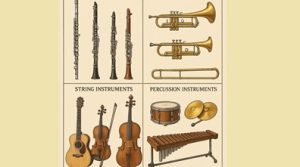Mastering the Bass Clef Notes
Mastering the Bass Clef Notes
If you are very serious about learning bass clef notes reading, then this is the best place for you. It is a step by step guide for the entire process.

Introduction to the Bass Clef
An association of notes to be found on the staff and their corresponding keys on the piano will be instituted with this clef just like in the treble clef.
This way visualizing the notes will work, and one will always know which octave is correct.
What is a Bass Clef?
Bass clef in music is the counterpart of treble clef; treble refers to all higher notes, while bass is a cover for notes around and below middle C.
It makes reading music in lower octaves easier without the need for excessive ledger lines.
How to Read Bass Clef
Eventually, reading bass clef is going to become natural like reading words. Familiarity is the key. One can understand bass clef staff and then mnemonics to aid memorization.
Bass Clef Staff
The musical staff consists of five horizontal lines with spaces in between. The clef symbol at the beginning of the staff dictates how the notes will be read. In bass clef:
- Middle C (C4) is on the first ledger line above the staff.
- The line between the bass clef dots represents F (hence the name F clef).
- Once these reference points are known, other notes become easier to identify by counting up or down.
C4: Our Reference Point
We are going to use C4 (middle C) as our first reference point. In fact for a bass clef, C4 is on the first ledger line above the staff when it is placed contrary to its position in treble clef.
So we’ll move down the staff one note at a time from C4:
- B3 – Located in the space just above the staff.
- A3 – On the top line of the staff.
- G3 – Found in the highest space of the staff.
- And so line and space corresponds to the next note up or down.
Dividing the Bass Clef Notes
To grasp the essentials, we divided bass-clef notes into four basic areas:
Area #1: C3 to C4
The middle range of the bass clef
Area #2: B2 to C2
Lower into the bass range.
Area #3: D4 to G5
Above the bass clef staff.
Area #4: B1 to A0
Contains the lowest notes on the piano.
Quick Conversion from Treble Clef
If you already read treble clef, here’s a simple trick to convert notes to bass clef:
- Pretend the note is in treble clef.
- Shift up two notes.
- Subtract two octaves.
Example:
- A4 in treble clef →Add two notes (C5)→Subtract two octaves→C3 in bass clef.
- Doing the same with D5 in the treble clef would lead you to subtract two notes to reach F3 in the bass clef.
- C4 in treble clef→Add two notes (E4)→Subtracting two octaves gives you a bass clef E2.
- Add two notes (C5) to A4 in the treble clef; Subtract two octaves = C3 in the bass clef.
- Add two notes (F5) to D5 in the treble clef; subtract two octaves = F3 in the bass clef.
- Two notes (E4) were added to C4 in treble; subtracting two octaves leads us to E2 in bass.
You’ll get quicker at these, with some time and practice, but the idea is to recognize bass clef notes right away with no tricks necessary.
Mnemonics for Bass Clef Notes
Here are a few memory cues for those who would like to use mnemonics:
Lines of bass clef staff:
- Good Boys Do Fine Always (G2, B2, D3, F3, A3)
- Good Birds Don’t Fly Away-as alternative.
Spaces of bass clef staff:
- All Cows Eat Grass (A2, C3, E3, G3)
The Drawbacks of Mnemonics
Mnemonics are not without their limitations. They include the following:
- They give no hint of the octave numbers, which makes it more difficult to pin down place on the piano.
- They ignore ledger lines and extra spaces-key pieces of information when it comes to reading a full range of notes.
- They bring to bear all the evils of crutches that prevent real memorization.
Next Steps: Practicing Bass Clef Notes
In our next session, we are going to learn valuable practice methods that will help firm that close understanding into solid reality. The most fruitful practice would be the habitual daily practice over five minutes.
Long-term results come through consistent short-term practices.
Get set to beef up those reading skills on the bass clef-so Happy Practicing!
Fastest Frequently Ask Question
What’s the best way to memorize bass notes in the treble?
Memorizing bass clef notes becomes easier for beginners by word association.
For example, for lines (G, B, D, F, and A), remember Great Big Dragons Fly Away. For spaces (A, C, E, G) remember it as All Cars Engine Growl.
Some easy-to-understand phrases will help recall the notes quickly, using these phrases in some way.
What are the notes in the scores of the bass clef?
The lines from the bottom of the bass clef upward are G, B, D, F, and A.
The four spaces are A, C, E, and G. Knowing the above characters will make reading mostly sweet music for anyone in the bass clef.
I want to learn about faster-read bass clef.
You start with the reference notes of course: F goes on the fourth line, and C appears just above the staff on a short ledger line.
Once you have these points, you can count up or down to find other notes. A lot of practice gradually trains speed and confidence.
Has a musician a reason for using bass clef?
The bass clef `keeps low-pitched notes` on the five lines of the staff to read.
There would have been many extra ledger lines to read sheet music through such reading if the bass clef had not been present.
What instruments usually play in bass clef?
The instruments and voices producing lower pitches typically employ bass clef:
- Strings: Double bass, Cello, Bass guitar
- Brass: Trombone, Tuba, Euphonium
- Woodwinds: Bassoon, Contrabassoon
- Keyboards: Piano (left hand), Organ (left hand)
- Percussive: Timpani
- Vocalists: Baritones and bass singers






Fun Sun – ваш надежный туроператор для путешествий в Турцию из Москвы, забронируйте.
Туроператор Fun Sun туры в Турции из Москвы [url=https://www.bluebirdtravel.ru/]https://www.bluebirdtravel.ru/[/url] .
r
Как выбрать дизайнерскую мебель премиум-класса.
Мебель премиум-класса [url=https://www.byfurniture.by]https://www.byfurniture.by[/url] .
Планируете незабываемую экзотическую почивку?.
Екзотични почивки за двама [url=https://ekzotichni-pochivki.com/]https://ekzotichni-pochivki.com/[/url] .
Антистресс игрушки для детей и взрослых.
Антистрес играчки за деца [url=http://antistres-igrachki.com/]http://antistres-igrachki.com/[/url] .
Отзывы родителей о куклах бебета.
Евтини кукли бебета [url=https://www.kukli-bebeta.com]https://www.kukli-bebeta.com[/url] .
hi
Желаете отправить букет без лишних хлопот?
Тогда вам стоит обратить внимание на интересную статью о http://tkaninfo.ru/novogodnij-kostyum-2017/kupit-gipsofilu-s-dostavkoj-stilnye-bukety-v-internet-magazine-azalianow.html в Москве.
Это просто находка для тех, кто ценит время.
Мы рекомендуем прочитать о том, как оформить заказ за пару минут.
Курьеры приезжают точно в срок, а букеты — как на фото.
Не упустите возможность подарить радость легко и быстро!
Как работать с контроллерами Siemens, для начинающих.
Лучшие практики программирования контроллеров Siemens, анализируем.
Преимущества TIA Portal в программировании контроллеров Siemens, для улучшения навыков.
Как избежать ошибок в программировании контроллеров Siemens, освойте.
Проектирование автоматизации с контроллерами Siemens, рекомендации.
Модели контроллеров Siemens и их особенности, для оптимальной работы.
Лучшие языки программирования для контроллеров Siemens, основы.
Автоматизация процессов с контроллерами Siemens, для всех сфер.
Современные тенденции в программировании контроллеров Siemens, какие изменения произойдут.
Разработка пользовательских интерфейсов для контроллеров Siemens, основные шаги.
Настройка контроллера сименс [url=http://programmirovanie-kontroller.ru/#Настройка-контроллера-сименс]http://programmirovanie-kontroller.ru/[/url] .
Лучшие ИБП для бизнеса, в обзоре.
Советы по выбору источников бесперебойного питания, в нашем блоге.
Почему стоит купить ИБП, в этой статье.
Топ-5 ИБП для защиты техники, узнайте.
Как выбрать идеальный источник бесперебойного питания, в нашем обзоре.
Покупка ИБП: на что обратить внимание, в нашем блоге.
Ваш идеальный ИБП, в анализе.
Все о принципах работы источников бесперебойного питания, разберитесь.
Эффективное использование ИБП, узнайте.
Инновации в области источников бесперебойного питания, посмотрите.
Как правильно подключить ИБП, здесь.
Как выбрать ИБП для разных нужд, узнайте.
Инсайдерские советы по выбору источников бесперебойного питания, в нашем анализе.
Рейтинг популярных источников бесперебойного питания, в гиде.
Пошаговая инструкция по установке ИБП, узнайте.
Обзор популярнейших источников бесперебойного питания, в гиде.
Как продлить срок службы ИБП, в статье.
Сравнение моделей источников бесперебойного питания, в статье.
Что учесть при выборе источника бесперебойного питания, в гиде.
бесперебойники [url=https://istochniki-bespereboynogo-pitaniya.ru/#бесперебойники]бесперебойники[/url] .
Виды мостовидных несъемных протезов.
Мостовидные несъемные зубные протезы [url=https://www.belfamilydent.ru/services/mostovidnoe-protezirovanie/]https://www.belfamilydent.ru/services/mostovidnoe-protezirovanie/[/url] .
Реальные отзывы о зубных мостах.
Зубной мост цена [url=http://www.koronki-blog.ru/mostovidnoe-protezirovanie]http://www.koronki-blog.ru/mostovidnoe-protezirovanie[/url] .
Имплантация на 4 имплантах: результаты и сроки.
Протезирование на 4 имплантах стоимость [url=http://www.belfamilydent.ru/services/implantaciya-allon4]http://www.belfamilydent.ru/services/implantaciya-allon4[/url] .
Лучшее качество при несъемном протезировании на 4 имплантах.
Протезирование зубов all on 4 [url=http://ggpatl.by/allon4-implantaciya/]http://ggpatl.by/allon4-implantaciya/[/url] .
Economical car hire with no extra costs
monthly car hire [url=http://rent-car-airport.com/paphos-long-term-rental/]http://rent-car-airport.com/paphos-long-term-rental/[/url] .
Мебель, которая создает атмосферу роскоши.
Мебель премиум-класса [url=https://www.byfurniture.by/]https://www.byfurniture.by/[/url] .
How to fix malfunctions in household appliances, tounderstandyour actions.
beginner’s guide to fixing appliances [url=https://www.technirepair.com]https://www.technirepair.com[/url] .
Лучшие кулинарные рецепты для праздничного стола, достойные вашего внимания.
Завтраки на каждый день: простые и вкусные рецепты, которые легко и быстро готовятся.
Топ 10 рецептов домашних десертов, с любовью и творчеством от поваров.
Изысканные рецепты национальных кухонь мира, которые стоит попробовать.
Семейные ужины, которые понравятся всем, достойные звания главного блюда на вашем столе.
Полезные блюда для поддержания здоровья, сделают ваше тело сильнее и здоровее.
Летние угощения: вкусные блюда для пикника, превратят ваш отдых на свежем воздухе в настоящий праздник.
Оригинальные рецепты напитков для вечерних посиделок, прохладят в жаркий день и согреют в холодный вечер.
Кулинарные хитрости и советы от опытных шеф-поваров, сделают вашу кулинарную практику более успешной.
Вегетарианские рецепты для здорового питания, которые не оставят равнодушными даже мясоедов.
Праздничные кулинарные угощения для детей, сделают детский праздник ярким и веселым.
Блюда, которые стоит готовить в разное время года, с учетом особенностей и потребностей вашего организма.
Легкие пикантные закуски к алкогольным напиткам, вызовут восторг у ваших друзей.
Идеи для меню на каждый день: простые и сытные блюда, которые спасут вас в быстром ритме жизни.
Конфеты, которые заставят вас влюбиться в сладкое, наполненные нежностью и теплом.
Как стать шеф-поваром в собственной кухне
быстрая и вкусная еда [url=https://www.7eda.ru#быстрая-и-вкусная-еда]https://www.7eda.ru[/url] .
Быстрое SEO для вашего проекта, для увеличения прибыли.
GSA ser [url=https://kwork.ru/links/41629912/seo-pushka-dlya-sayta-mnogourovnevaya-piramida-ssylok-pod-klyuch]https://kwork.ru/links/41629912/seo-pushka-dlya-sayta-mnogourovnevaya-piramida-ssylok-pod-klyuch[/url] .
Лучшие скины на рынке, гарантированные сделки.
новинки, которые.
популярных скинов, что.
последние новинки.
качественные скины.
сообщества.
Ищите.
Проверьте.
в онлайн-коллекции.
скины по суперценам, обрадуют вас.
коллекции скинов, которые вас вдохновят.
анализ цен.
уникальные скины.
Узнайте, как, чтобы не упустить возможности.
Следите за, удовлетворят ваши потребности.
исключительными предметами, что сделает вас особенным.
Покупая у нас, бесподобный выбор.
скины, которые были в тренде, по доступной цене.
buy skins [url=https://superskinscs.com/#buy-skins]https://superskinscs.com/[/url] .
Как оформить разрешение на работу, для иностранцев, рекомендуется ознакомиться.
Работа за границей: что нужно знать о разрешении, подробный гайд.
Все о Разрешении на работу, разбираем.
Что делать, если истекает разрешение на работу, рекомендации.
Разрешение на работу для студентов, проверенная информация.
Как избежать ошибок при получении разрешения на работу, советы от экспертов.
Сравнение разрешений на работу в разных странах, требования.
Документы для получения разрешения на работу, требуемые документы.
Причины отказа в получении разрешения, важные советы.
Разрешение на работу: права и обязанности работника, подробности.
Сроки получения разрешения на работу, полезная информация.
Как фрилансеру получить разрешение на работу, полезные советы.
Где узнать о готовности разрешения на работу, все способы.
Как получить разрешение на работу родителям-одиночкам, пошаговый план.
Советы по интервью для разрешения на работу, как пройти успешно.
Налогообложение для работников с разрешением, информация.
Как получить разрешение на работу инвалидам, основные моменты.
Сколько стоит получение разрешения на работу, финансовые аспекты.
Переезд и работа: разрешение на работу, планирование.
Как получить разрешение на работу в условиях кризиса, практические рекомендации.
получить рнр [url=http://www.oformleniernr.ru#получить-рнр]http://www.oformleniernr.ru[/url] .
Народные приметы [url=http://topoland.ru]http://topoland.ru[/url] .
Looking for authentic natural locs?
Discover the finest natural dreads at natural dreadlocks, your leading store for dreads natural hair online.
Our selection of natural locs offers handcrafted extensions made from 100% human hair, ensuring a flawless blend for every hair type. Whether you want short natural dreads or customized natural dreadlocks hair, we have the perfect set.
Why choose our natural dreadlocks for sale?
– 100% human hair for lasting beauty and natural feel.
– Expertly crafted by skilled artisans to blend seamlessly.
– Available in a wide range of colors, including classic natural tones.
– Suitable for long-term wear
– Fast delivery with reliable service.
Buy natural dreadlocks that offer comfort and style. Our dreads natural are perfect for adding volume and length without compromising authenticity.
Explore the best natural dread products and take your hairstyle to the next level with realistic natural dreadlocks hair. Whether you are seasoned in natural hair styles, we provide quality, style, and expert guidance.
Order now from Looking for authentic natural locs?
Discover the finest natural dreads at [url=https://dreadlocksart.com/natural-dreadlocks/]natural dreadlocks extensions[/url], your go-to shop for dreads natural hair online.
Our selection of natural dreadlocks offers premium-quality dreads made from 100% human hair, ensuring a flawless blend for any style. Whether you want long natural dreadlocks or customized natural dreadlocks hair, we have just what you need.
Why choose our natural dreadlock extensions?
– Real human hair for lasting beauty and natural feel.
– Expertly crafted by skilled artisans to blend seamlessly.
– Available in various lengths and shades, including classic natural tones.
– Suitable for long-term wear
– Fast US shipping with reliable service.
Buy natural dreadlocks that offer comfort and style. Our dreads natural are ideal for anyone looking to enhance their look without compromising authenticity.
Explore the best natural dread products and take your hairstyle to the next level with realistic natural dreadlocks hair. Whether you are seasoned in natural hair styles, we provide quality, style, and expert guidance.
Order now from [url=https://dreadlocksart.com/natural-dreadlocks/][/url] — your destination for natural dreadlocks. — where natural dread hair meets artistry.
[url=https://tokarnye-stanki-s-chpu.ru/]токарный станок с чпу настольный[/url] — это современное оборудование для точной обработки металла и дерева.
Эти устройства позволяют выполнять высокоточную обработку металлических и неметаллических заготовок.
Автоматизация токарных работ минимизирует человеческий фактор и ускоряет выполнение задач. Сегодня станки с ЧПУ используются в машиностроении, авиации и других отраслях промышленности.
#### **2. Принцип работы токарных станков с ЧПУ**
Работа оборудования строится на заранее созданной программе, определяющей последовательность обработки.
Система обратной связи позволяет корректировать работу станка в режиме реального времени. Таким образом, достигается высокая повторяемость деталей и минимальные отклонения от чертежа.
#### **3. Преимущества токарных станков с ЧПУ**
Основным преимуществом является возможность выполнения сложных операций без ручного вмешательства.
Автоматизация процесса позволяет сократить производственные издержки. Дополнительным плюсом является возможность быстрого перехода на выпуск новых изделий.
#### **4. Перспективы развития токарных станков с ЧПУ**
Развитие технологии приведет к созданию более умных и автономных систем.
Подключение к цифровым платформам даст возможность оптимизировать работу станков в режиме онлайн. Это откроет новые возможности для промышленности и ускорит переход к «умным» заводам.
—
### **Спин-шаблон:**
#### **1. Введение в токарные станки с ЧПУ**
Современное производство сложно представить без токарных станков с ЧПУ. Такое оборудование обеспечивает точное и быстрое изготовление деталей из различных материалов.
Применение ЧПУ сокращает время производства и уменьшает количество брака. Сегодня станки с ЧПУ используются в машиностроении, авиации и других отраслях промышленности.
*(Шаблон продолжается аналогично для всех последующих разделов.)*
Рейтинг ТОП-10 онлайн-казино России создан для игроков, которые хотят сочетать азарт и надежность. Эти площадки позволяют пополнять счет в рублях, играть в слоты и настольные игры, а главное — быстро выводить деньги на карту. Мы выбрали только лицензированные сайты с бонусами и прозрачными условиями. Полный список лучших казино доступен на https://igrok777.fun/ Там вы найдете площадку, которая идеально подойдет для комфортной и безопасной игры.
If you are looking for a reliable [url=https://trafficarbitration.com/]replacing garage opener[/url], contact our company in Englewood, Florida.
Another essential factor is the range of services offered. While some businesses may offer mainly installation services, others might be experts in repairs and maintenance. Selecting a firm that covers all service aspects ensures you have support whenever needed.
Discover the elegance and reliability of [url=https://best-interwood.com/]deluxe garage doors[/url], which will add a unique style to your home in Englewood, Florida.
To ensure optimal performance, it’s best to have deluxe garage doors installed by skilled technicians. A proper installation guarantees the doors function effectively and last longer.
Moreover, a variety of online casinos provide attractive bonuses and promotional offers to draw in new users. Such bonuses can improve the overall gaming experience and boost players’ opportunities to win.
how to play roulette effectively [url=http://lecasinonet.com/2024/06/05/tips-for-playing-roulette]http://lecasinonet.com/2024/06/05/tips-for-playing-roulette[/url]
To build an effective marketing blog, it’s essential to identify your niche. Choose a topic that excites you and that you know well. Narrowing your focus will draw in a loyal audience.
DIY outlet installation [url=http://marketingpitbull.com/electrical-outlet-installation-getting-it-right-the-first-time]http://marketingpitbull.com/electrical-outlet-installation-getting-it-right-the-first-time[/url]
However, this rapid advancement in AI poses ethical questions and challenges that society must address. As we navigate this landscape, it becomes essential to balance innovation with ethical standards.
connected tech infrastructure [url=http://wmta-online.com/from-smart-homes-to-smart-cities-where-is-technology-taking-us-next]http://wmta-online.com/from-smart-homes-to-smart-cities-where-is-technology-taking-us-next[/url]
Wind energy is captured by using turbines that transform wind movement into electrical power. Optimizing wind energy production requires positioning turbines in wind-rich locations.
battery storage renewables [url=http://newsolarwindpower.com/?p=85]http://newsolarwindpower.com/?p=85[/url]
I don’t think the title of your article matches the content lol. Just kidding, mainly because I had some doubts after reading the article. https://accounts.binance.com/register?ref=P9L9FQKY
Social media marketing is another critical element of digital marketing . Engaging with customers on platforms like Facebook, Instagram, and Twitter can build brand loyalty .
marketing tactics 2025 [url=https://cb-top.com/mastering-the-art-of-customer-engagement-proven-marketing-tactics-for-2025/]marketing tactics 2025[/url].
Along with convenience, a greater variety of products is typically available at online pet shops.
species protection [url=http://petstorepetsupply.com/index.php/2025/05/31/wildlife-at-risk-the-worlds-most-endangered-species-in-2025/#species-protection]https://petstorepetsupply.com/index.php/2025/05/31/wildlife-at-risk-the-worlds-most-endangered-species-in-2025/[/url]
Front-end development focuses on the visual aspects of a website, including layout and design.
crafting websites [url=http://www.onlyblogthemes.com/2024/12/07/the-building-blocks-of-success-key-tips-for-crafting-a-winning-website#crafting-websites]https://onlyblogthemes.com/2024/12/07/the-building-blocks-of-success-key-tips-for-crafting-a-winning-website/[/url]
This insight allows consumers to stay ahead of price shifts and identify innovative products.
dependable shopping sites [url=storesonline-reviews.com/how-reliability-shapes-the-way-we-choose-where-to-shop#dependable-shopping-sites]https://storesonline-reviews.com/how-reliability-shapes-the-way-we-choose-where-to-shop/[/url]
кракен онлайн
kraken onion
кракен vk3
kraken СПб
кракен ios
кракен vk3
кракен Москва
kraken market
кракен vk6
kraken marketplace
kraken darknet
kraken android
kraken
кракен зеркало
kraken qr code
кракен qr код
kraken vk5
кракен официальный сайт
kraken ссылка
кракен android
кракен
kraken darknet
kraken ios
кракен маркет
kraken ios
kraken vk2
кракен онион
kraken онлайн
kraken vk4
kraken ios
кракен клиент
кракен актуальная ссылка
кракен даркнет маркет
kraken ios
кракен vk2
кракен Россия
kraken android
кракен vk2
кракен официальный сайт
кракен зеркало
kraken vk4
kraken marketplace
кракен vk6
kraken vk5
кракен android
кракен 2025
kraken обмен
кракен qr код
kraken tor
kraken darknet market
kraken vpn
kraken vk5
кракен вход
kraken marketplace
кракен ссылка
кракен вход
mega-sb актуальное
mgmarket4.at
адрес меги без тор
мега приложение
мега спб актуальная ссылка
мега арбитраж
mega.sb на сегодня
МЕГА сайт